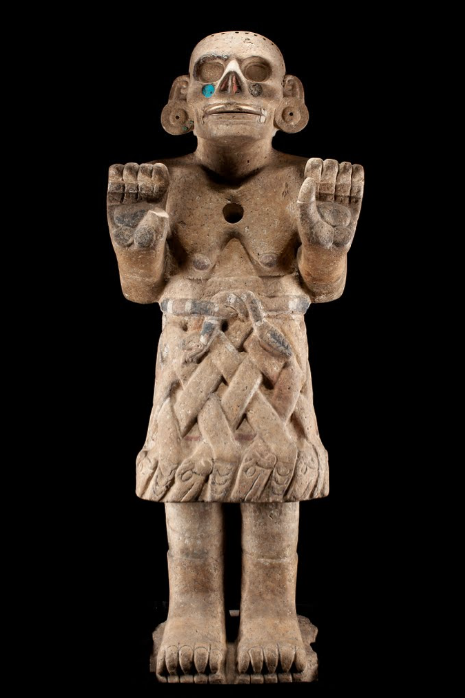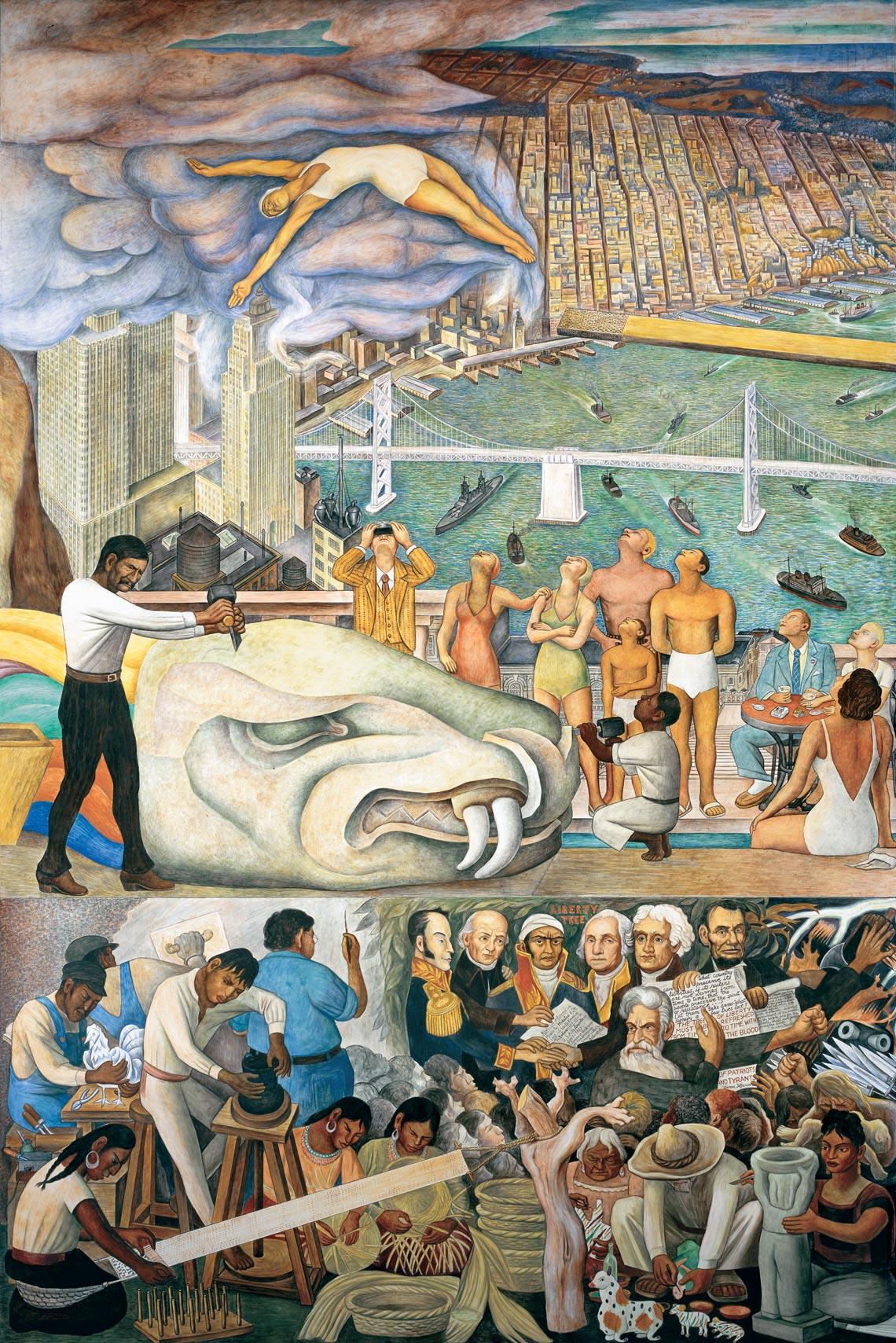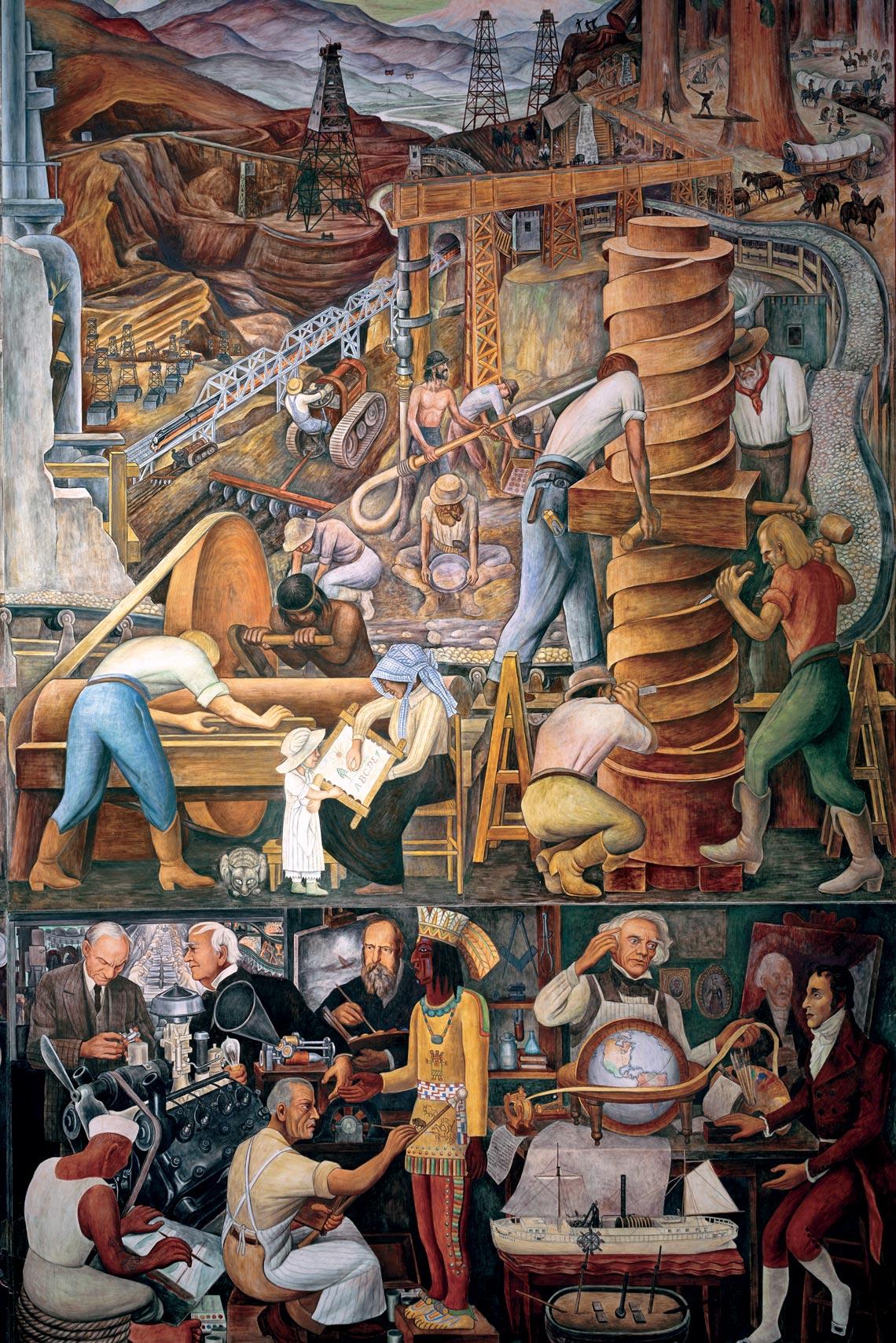Diego Rivera’s Pan-American Unity mural (figure 1) was revealed at the Golden Gate International Exposition on Treasure Island, a man-made piece of land in San Francisco Bay, in 1940. During a time of war and uncertainty, the artist conceived of an alternative where technology can be implemented in the service of liberating and uniting the working class in the Americas. This essay explores Rivera’s mechanization of Coatlicue in this mural as a way to tap into the opposing potentialities of technological advancements during World War II. The dualistic qualities of the Aztec monument Rivera paints in the center of his composition emphasizes the power of machines to change society.
Diego Rivera, Pan-American Unity (1940)

Fig. 1. Diego Rivera, Unión de la Expresión Artistica del Norte y Sur de este Continente (also called Pan-American Unity), 1940, fresco on plaster, City College of San Francisco, 6.7 x 22.6 m (264 x 888 in.) [Link to source]
The Golden Gate International Exposition of 1939 highlighted art, architecture, and lighting. When it was originally planned, the world's fair was intended to celebrate the inauguration of the Golden Gate and San Francisco bridges. Over the course of the project's development, the theme began to change to unify countries and continents on the Pacific Ocean through a celebration of their technological achievements. Advancements such as machinery, architecture, art, science, and other enterprises were exhibited at this event. Timothy Pflueger, a successful architect and entrepreneur who developed several buildings in the San Francisco Bay area, commissioned Rivera to create a mural that would showcase great accomplishments of the Americas, including his own buildings, of course.1 The reputation of the artist for taking many liberties in his designs was consistent in this example and its inherent political nature. Following the world's fair, the mural was relocated to the City College of San Francisco, where one can see it today.2
Rivera split the mural into five panels (numbered from left to right), each highlighting particular advancements in the history of the Americas. The central panel comprising the focus of this essay will be discussed last in order to emphasize the dialectical potential of technology emerging from the elements flanking it. Panel one (figure 2) depicts people in various scenes of Pre-Columbian Mesoamerica. Divided into an upper and lower register, the top register features clusters of people engaging in the creation of Mexico’s cultural roots. Toltec artisans work together to polish and carve a cylindrical stone sculpture incised with a design of a figure while Quetzalcoatl teaches the ruling council. The lower register features a metal artisan workshop, where gold jewelry was made using the lost wax casting method. This technique involved creating a model of a design molded with wax that was melted down and replaced with the desired metal. To the left of the workers is Nezahualcoyotl, who was a 15th-century king of Texcoco and an apparent inventor of a flying machine. Interestingly, the pamphlet distributed by the 1940 Golden Gate International Exposition called this figure the “Leonardo da Vinci of Mexico" to connect the intellectuals of the Americas with the Western world.3 The technicolor feathered serpent slithers through these scenes of cultural development, with its head and fanged mouth resting at the start of the proceeding panel.
The second panel (figure 3) shows historical figures from the United States and Mexico during the colonial and modern periods. Chiseling the head of the plumed serpent is the great Mexican sculptor Mardonio Magaña, whose work was championed by Rivera. Next to the serpent is a crowd of onlookers watching Olympic diving champion Helen Crlenkovich elegantly dive towards the San Francisco Bay.4 The lower register features contemporary artists and artisans from Mexico, including Diego Rivera, who paints the liberty tree that Thomas Jefferson says must be “refreshed from time to time with the blood of patriots and tyrants.”5 Along with an author of the Declaration of Independence, the artist included other historical figures such as Abraham Lincoln, Miguel Hidalgo y Castilla, Simón Bolivar, and John Brown. Each of these notable people share the present themes of liberty and justice in the work for which they are most remembered. Lincoln was known for delivering the Gettysburg Address and emancipating slaves in the United States after Bolivar did the same in Latin America decades earlier. However, an interesting ambiguity exists in Rivera’s decision to include historical figures with a connection to a broad definition of liberty. For example, Jefferson, who partially wrote a document calling for the freedom and independence of the United States from England, was also known for owning well over one hundred slaves in his lifetime.6 This ambivalence lends a sentiment of uncertainty, allowing the viewer to contemplate the ability of societal advancements to either exploit us, or liberate us all.
Moving from the outside in on the right half, panel five (figure 4) shows the colonial period in the United States. Caravans and horses signify Manifest Destiny and expansion out West which directly resulted in the displacement of Indigenous people and the unfathomable destruction of their land. Excavators are placed in mining rigs alongside wooden mechanized elements like a giant screw created by early industrialists. The lower panel shows colonial Americans painting and cataloging Indigenous people with the false idea that they would “vanish.”
While the entire mural has dialectical qualities, Panel four illustrates the very split between the potentialities of technology (figure 5). The top register shows the glory of architecture and cultural advancements through the depiction of architects and artists situated above the San Francisco Bay, Treasure Island, and Alcatraz. The figures watch in amazement as Helen Crlenkovich, Olympic diving champion, again performs an elegant swan dive into the Bay in a symmetrical configuration with the similar depiction from panel two. The bottom register is in stark contrast to the one above it. Hitler and Stalin stand in the center armed with weapons as the electricity from a barbed wire fence casts lightning through the middle of the composition. Distorted figures take cover as the explosion takes place next to war planes and parachutes. The high contrast between light and dark alludes to the dualistic potential of innovation to hurt (technology in the hands of authoritarian leaders) or help humanity (technology empowering workers by lessening the physical burden of their exploitation).
A partially mechanized Coatlicue takes up almost the entirety of the mural’s prime real estate as the central and most important figure (figure 6). Its industrial fangs curl outwards, intimidating the viewer with its monumentality and fierce characteristics. The body of the Coatlicue is layered with machinery, referencing an earlier iteration of this deity in Rivera’s mural painted at the Detroit Institute of the Arts (DIA).7 The Coatlicue in this mural was the steel press used to produce the exterior body of motor vehicles in line with the Ford automotive plant situated in close proximity to DIA. There is a danger involved in working with such machinery where the very technology that improves efficiency can also cause great harm to those who use it. Modeling this version of Coatlicue after the steel press calls attention to the ways in which blue collar workers sacrifice their bodies for the items they produce for the masses.
While the overall silhouette and serpent skirt clearly designates this figure as a direct reference to the Coatlicue Mayor, a well-known example of Aztec monumental art, this version has been adapted to become further Pan-American through its iconographic modifications. The brown flesh-toned hand of Coatlicue is exposed to the viewer, showing the greenstone set into her palm to create a jaguar paw, similar to the Coatlicue of Coxcatlan (figure 7). A half-skull, half-flesh head sits at the center of her midsection, partially covered by the intruding bighorn ram being worked on by the Canadian sculptor Dudley Carver.8 The bottom of the composition contains people Rivera knew such as Frida Kahlo, Paulette Goddard, Timothy L. Pflueger, and children of people the artist met. Rivera can be seen holding the hands of Goddard, a choice the artist made to express Pan-American sentiments as he stated.

Fig. 7. Coatlicue of Coxcatlan, c. 1500 CE, Basalt with pigment and inlaid turquoise and shell, 115 x 40 x 35 cm. Museo Nacional de Antropología, INAH, Mexico City. [Link to source]
The term ‘Pan-American’ has its roots in the politics of James Blaine, a former presidential nominee who sought to expand trade relations between the United States and the Americas at large.9 However, Blaine was also a proponent of controlling island territories such as Hawaii for trade purposes and political annexation. An alternative reading of this term has to do with another movement called Pan-Africanism, which began as a way to create a sense of unity among all people of African ancestry amid efforts to liberate the continent at large from colonial powers in the early twentieth century.10 The foundation of Pan-American unity for Rivera directly related to bringing people together for the Golden Gate International Exposition, but the roots of the term consider other conversations related to politics that were happening at the same time. Rivera’s mechanized Coatlicue brings together the past and present from parts of the Americas to illuminate the potential for unity of people and technology to create a better world.
This partly mechanized version of the Coatlicue monument visually demonstrates its function as a political tool throughout its history. Before delving into Rivera’s central figure, it is necessary to discuss the Coatlicue monument as a machine created to accomplish a set of goals. Frederico Navarrete Linares discusses the stone Coatlicue monument as part of a broader attempt to understand Aztec monoliths through their functionality instead of analyzing their many symbols.11 The definition of functionality discussed here has to do with the intended effects the monuments had on humans, deities, and the reality between them. The magnitude of the Coatlicue Mayor monument signifies the amount of work put into its creation, which takes place over time. Navarrete Linares argues that Aztec monuments have the essential function of being reality-shaping devices that account for the temporality of their initial creation, and subsequent actions taken to keep the monument “alive” as it relates to divine embodiment or ixitptla.12 The culmination of many symbols on the Coatlicue creates a sense of ambiguity for what it represents and the implied meanings behind them. Navarrete Linares argues that this sensibility was key to the ritual and cosmic functions of the monument. Rivera’s own characterization of this monolith as half-stone and half-machine manifests this uncertainty about the potential for technological advancements to be destructive or beneficial. The split within the central figure highlights the need to balance unfettered industrialization and modernization with traditional values. It should be noted that dangers exist when the balance is skewed towards either tradition or unregulated industrialization; just as technology can be used for weapons of war, swearing off its usage entirely can limit the progress of society.
The Coatlicue Mayor monument functioned as part of the sculpture complex of the Aztec, contributing to an ideology of covenant between the gods, the ruling authority, and the people. The significance of the Coatlicue monument transformed towards the end of the Mexican revolution, when she became a symbol of Mexicanidad—the quality of being Mexican as it relates to indigeneity and national heritage—and Mexican Modernists like Rivera adopted her to serve the people of the Mexican nation. Navarrete Linares suggests that Aztec monuments like the Coatlicue Mayor are analogous to machines because they were created and shaped to accomplish a set of tasks.
Rivera’s divided Coatlicue serves as the centerpiece of Pan-American Unity. The stone side of the sculpture calls back to her role in Mexico’s political past and present, while the mechanized side represents her potential to function as a symbol of a unified future between people in the Americas and the world at large. The fact that the monument is split in half harkens back to the ambiguous qualities of the original Coatlicue sculpture while calling attention to the duality of potential for progress. The mural was created during the onset of the Second World War, a dichotomous period of both incredible achievements and horrific historical events. Technology being created at the time could have easily been used to make the world a better place but much of it was instead used to manufacture tools of war. By having a mechanized Coatlicue at the center of his composition, Rivera asked the patrons of the Golden Gate International Exposition to consider the future of technology and its impact on the world. In separating the panels of his mural, he shows us where humans can work together in solidarity. Contrastingly, we can also see the consequences of harnessing our potential for violent ends.
-----------------------------------------------------------------------------
1. Diego Rivera, and Timothy L. Pflueger, “Agreement for Diego Rivera to Paint a Mural in the Art in Action Section of the Palace of Fine Arts in the Golden Gate International Exposition on Treasure Island in San Francisco,” 1940. https://riveramural.org/letters/#letter2.↩
2. In 2017, the mural was temporarily relocated to the San Francisco Museum of Modern art during an effort to conserve the painting.↩
3. Dorothy Puccinelli, Diego Rivera: The Story of His Mural at the 1940 Golden Gate International Exposition. (San Francisco, 1940), 3.↩
4. "Diego Rivera: His amazing new mural depicts Pan-American unity." Life Vol. 10, no. 9 (March 3, 1941), 52.↩
5. Thomas Jefferson to Williams Stephens Smith, November 23, 1787. https://founders.archives.gov/documents/Jefferson/01-12-02-0348.↩
6. Jan Ellen Lewis, “'A Beautiful Domestic Character:' Sarah N. Randolph’s The Domestic Life of Thomas Jefferson” in Thomas Jefferson’s Lives: Biographers and the Battle for History. (Charlottesville: University of Virginia Press, 2019), 100.↩
7. Diana Magaloni, “Diego Rivera and Coatlicue: Towards a Mestizo History of American Modernity,” in Picasso, Rivera: Conversations across Time, edited by Diana Magaloni and Michael Govan, (Los Angeles: Los Angeles County Museum of Art, 2016), 67. ↩
8. Arno P. Schniewind, Roger Baird, Dale P. Kronkright, "Rescuing Dudley Carter's Goddess of the Forest," WAG Postprints, (1996): 3. ↩
9. Edward P. Crapol, James G. Blaine: Architect of Empire. (Wilmington: Scholarly Resources, 2000), 57.↩
10. J. Ayodele Langley, Pan-Africanism and Nationalism in West Africa, 1900-1945: A Study in Ideology and Social Classes, (Oxford: Clarendon Press, 1973): 27.↩
11. Federico Navarrete Linares, “Aztec Monoliths as Time-Shaping Devices: Coatlicue, Piedra Del Sol and Piedra de Tízoc,” Revista de Antropologia (São Paulo) 62, no. 3 (2019), 747.↩
12. Navarrete Linares, “Aztec Monoliths,” 751.↩





